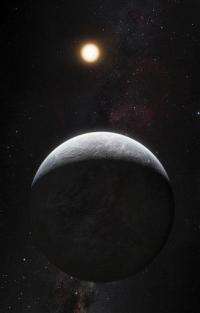Hot new planet could be in habitable zone -- barely

Astronomers believe they have found a second planet outside our solar system that seems to be in the right zone for life, just barely. But it would feel like a steam bath - hot, sticky and beyond uncomfortable.
European astronomers announced the discovery Monday along with about 50 other planets outside our solar system at a conference in Moran, Wyo. The most exciting of those planets is only the second to be confirmed as lying in what astronomers call the habitable zone, or the Goldilocks zone. That means it's not too hot and not too cold for liquid water to be present. Water is the key to a planet being able to support Earth-like life, scientists say.
Only one of the past discoveries of such Goldilocks planets has held up. That was a planet found in 2007. And even this new one comes with an asterisk: The planet would need to have water and be a rocky, solid planet like Earth, not one that's primarily gas like Jupiter.
The new planet is about 3.6 times the mass of Earth. Temperatures there may range from 85 to 120 degrees with plenty of humidity.
"It's going to be really muggy, just think about the muggiest (Washington) day you can think of," said study author Lisa Kaltenegger, an astronomer with the Max Planck Institute in Germany. "We're not saying it's habitable for you and me."
But other types of life - probably shorter and squatter life - could conceivably take root there, she said. They would probably be closer to the ground than humans because gravity on this larger-than-Earth planet is about 1.4 times what we experience, she said.
For it to be considered livable by astronomers, at least 60 percent of it would have to be covered in clouds, said Kaltenegger. Earth has about 50 percent cloud cover, so 60 percent seems reasonable, she said.
The new planet, called HD85512b, closely circles a star about 35 light-years from Earth in the constellation Vela. Each light-year is 5.8 trillion miles. A year there is only 60 days. The only reason it might not too hot for life is that its sun is about 1,800 degrees cooler than our sun, Kaltenegger said.
The new batch of planets, including the potentially habitable one, were found by the European Southern Observatory's special planet-hunting instrument called HARPS is based in Chile. The finding doubles the number of planets that are closer to Earth in mass than those closer to Jupiter's size.
Reports on them appear in four papers published in scientific journals to coincide with the Wyoming conference, Extreme Solar Systems II. This new planet was observed more than a thousand times over 200 nights of tracking from Chile so astronomers are confident with their findings, said study author Francesco Pepe of the Geneva Observatory in Switzerland.
In addition to the two European discoveries of potentially habitable planets, a NASA telescope has identified more than 50 other candidates, but those still need further confirmation.
©2011 The Associated Press. All rights reserved. This material may not be published, broadcast, rewritten or redistributed.




















